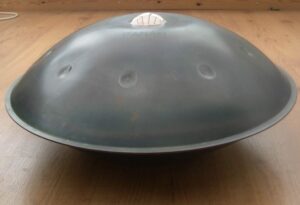The handpan is a relatively new instrument in the world, having been first invented in 2001. However, the origins of tuned steel itself, the primary concept involved in creating the tone of the handpan, ca n be traced back to the 1930s and 1940s in the islands of Trinidad and Tobago.
n be traced back to the 1930s and 1940s in the islands of Trinidad and Tobago.
For now, we will not focus on the history of the steel pan. A separate article will be published on the history of the steel pan, as it definitely deserves it’s own page!
A company by the name of PANArt, based in Bern, Switzerland was the first to create a tuned steel instrument to be played by the hands. The name of their instrument was the ‘Hang’. Before creating the Hang, PANArt was a steel pan manufacturer for many years. In this time, PANArt did extensive research in the world of tuned steel. They explored different forming methods of the steel, along with experimenting with heat treating the metals they used in order to make a consistent and proper material that would be ideal for tuning. They also came up with new tuning concepts altogether which were different than the tuning methods that originated from Trinidad and Tobago.
At one point, a musician approached PANArt by the name of Reto Weber, and requested to have an instrument made that could be played with just the hands, as opposed to the mallets used to play steel pans. PANArt took their research from the past many years and applied it to this new form of tuned steel. The Hang was born.
At first, the Hang was sold by only a few select distributors around the world. Acquiring an early version of the instrument required someone to get into contact with these distributors, and it was not uncommon for them to sell out quickly. Years passed, and eventually PANArt only sold the Hang from their workshop. An in-person visit to the PANArt workshop was required to retrieve the Hang, and it was invitation only.
Eventually, the allure of the Hang took hold, and demand for the instrument skyrocketed. Other steel pan builders saw this new demand and focused their efforts on creating something similar.
As the term ‘Hang’ is a registered trademark of PANArt, these other companies had to come up with a universal term for this hand-played steel instrument. There has been much debate in what term should be used, but now the most commonly used word is “handpan”, a term introduced by the company “Pantheon Steel” who makes the Halo handpan.
PANArt has said, on many occasions, that the hang is not a handpan. Their reasoning is that the hang is crafted using techniques not seen in the steelpan and handpan world. Specifically, it has to do with the structure of the notes themselves, and how the tone fields are formed and tuned. The Iskra sound sculpture, made by Symphonic Steel, is based upon these unique forming and tuning methods devised by PANArt.
PANArt has since stopped producing the Hang. However, they have continued to tune steel in slightly modified forms, and now have many different tuned steel instruments offered.
The evolution of the handpan by the various crafters around the world has also led to more notes on the top shells, and even adding notes to the bottom shells as well. Other materials have been experimented with and used. Low-voiced bass handpans have even been produced, consisting of only a few, but very low-pitched notes, on one handpan.
It’s clear that these instruments are still very young, and much more evolution will be seen in the years to come.
